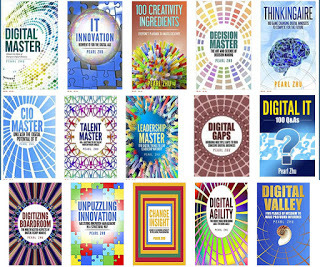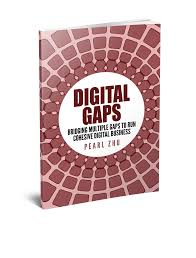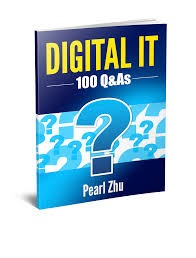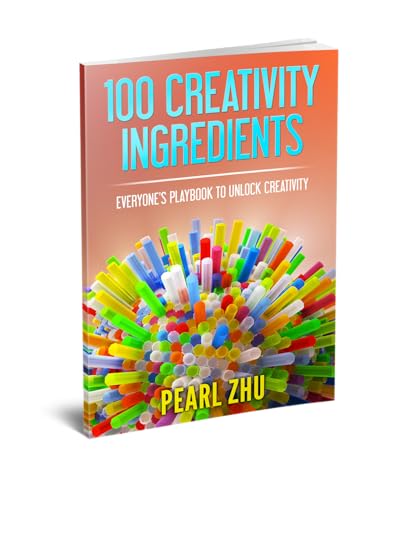Pearl Zhu's Blog, page 1229
May 13, 2017
The Metaphorical Perception about Digital Transformation
 The shift to digital cuts across industrial sectors, geographic territories, and leadership roles. The digital transformation is now spreading rapidly to enable organizations of all shapes and sizes to reinvent themselves. Change is inevitable, and the speed of change is increasing. Although we have to change with the "tide," we have to stand firm on our principles which would guide us to change for better and forward. We have to engage our sixth sense to decipher when to make incremental changes, and when to make a leap. We also have to reimagine the art of possibility, and convey a clear vision with vivid analogs or metaphorical perceptions about digital transformation, to make the journey fun, innovative, goal driven and laser focus.
The shift to digital cuts across industrial sectors, geographic territories, and leadership roles. The digital transformation is now spreading rapidly to enable organizations of all shapes and sizes to reinvent themselves. Change is inevitable, and the speed of change is increasing. Although we have to change with the "tide," we have to stand firm on our principles which would guide us to change for better and forward. We have to engage our sixth sense to decipher when to make incremental changes, and when to make a leap. We also have to reimagine the art of possibility, and convey a clear vision with vivid analogs or metaphorical perceptions about digital transformation, to make the journey fun, innovative, goal driven and laser focus.
The classic transformation metaphor: The renowned metaphor of the caterpillar that becomes a butterfly demonstrates the digital transformation vividly and beautifully. As the caterpillar begins the transformation process, it still has mobility and more than less its qualities of being a caterpillar. As the caterpillar to butterfly transformation process reaches the “tipping point,” "being a caterpillar" status is disrupted, and the following parts of the process that produce the butterfly begin. The caterpillar becomes totally dysfunctional and can not be recognized as a caterpillar any longer, the transformation reaches the inflection point, only then can the butterfly emerge. This beautiful nature phenomenon also vividly describes the journey of digital transformation. Continuous digital disruptions today allow for “new” energy to flow and bring with it something that would not be born without it. Dealing with the challenge of digital transformation requires accelerated digital mindsets, leveraging multidisciplinary knowledge and insight, taking an end-to-end response and a structural approach. A highly diverse group almost always accelerates innovation dramatically as well as spurs general creativity. When the business can truly reinvent itself based on a unique set of capabilities, and then a high-innovative, high mature digital master is fully developed, not for controlling, but further propelling for the next level of progress.
The classic fable about change for survival in the animal world: There is a classic fable about a lion and a gazelle to analogize such a "surviving and thriving cycles." The lion wakes up and starts running, otherwise it will not catch lunch. The gazelle does the same but, in this case, to avoid becoming lunch. Either way, you have to move to survive. Digital businesses today are also facing the fierce competitions and unprecedented uncertainty and velocity. Hence, changeability for either individuals or organizations are no longer “nice to have,” but “must have” capability, not only for surviving but for thriving. “Moving out of the comfort zone” is challenging for many people, but it is the prerequisite for either change or innovation. It takes courage, motivation, discipline and persistence to get out of comfort zone. It might sound like a cliche, the trick is understanding that moving out of a comfort zone leads to the creation of a new comfort zone which in turn will require you to move out "of" it again. This continuous moving "out" of your comfort zone or throw yourself a curve is complemented by the cycle of self-development -discovery, autonomy, and mastery.
 The hyperconnected, and highly innovative digital business or world can also be analogized by the pollination phenomenon in the nature world: Pollination is needed for plants to reproduce in the nature world, and so many plants depend on bees or other insects as pollinators. Digital innovation today also needs to be catalyzed via such digital pollination based on the enterprise social platforms or tools. Innovative organizations naturally have closer connections between functions and all functions and levels are more intimately involved with the market and each other on a regular basis, based on flatter social and organizational structures. Policies, processes, and commitment (resources, not words) from top management should establish and foster curiosity. To continuously innovate within organizations, individuals and groups need to connect and communicate more openly, easily and effectively. To amplify innovation effect, it is important to make the cross-pollination of ideas and a close connection to the market for all parts of the organization. These innovation communities can be engaged in offering ideas, enhancing these ideas by combining and building upon one another to shape solutions and work together to implement resulting innovations, and then further extend into innovation hubs or clusters. This collective action enhances the innovation experience and leads to higher diffusion rate and create significant business values.
The hyperconnected, and highly innovative digital business or world can also be analogized by the pollination phenomenon in the nature world: Pollination is needed for plants to reproduce in the nature world, and so many plants depend on bees or other insects as pollinators. Digital innovation today also needs to be catalyzed via such digital pollination based on the enterprise social platforms or tools. Innovative organizations naturally have closer connections between functions and all functions and levels are more intimately involved with the market and each other on a regular basis, based on flatter social and organizational structures. Policies, processes, and commitment (resources, not words) from top management should establish and foster curiosity. To continuously innovate within organizations, individuals and groups need to connect and communicate more openly, easily and effectively. To amplify innovation effect, it is important to make the cross-pollination of ideas and a close connection to the market for all parts of the organization. These innovation communities can be engaged in offering ideas, enhancing these ideas by combining and building upon one another to shape solutions and work together to implement resulting innovations, and then further extend into innovation hubs or clusters. This collective action enhances the innovation experience and leads to higher diffusion rate and create significant business values.
Digital transformation is both the art and science. The art of digital is to connect the old and new, but ultimately transform and advance, to embrace the full spectrum of colors or all sorts of shapes. The science of digital is to take a structural approach for dynamically transforming a mixture of systemic-intensity-related capabilities, maturities challenges, paradoxes, and delivering quantitative & qualitative business result with the steadfast speed.
Follow us at: @Pearl_Zhu
Published on May 13, 2017 23:27
May 12, 2017
The Monthly CIO Debates Collection: From Debating to Innovating May, 2017
Debating is not for stimulating conflicts, but for brainstorming better ways to do things.
 Modern CIOs face many challenges, it is not sufficient to only keep the lights on. Regardless of which industry or the nature of organization you are in, being a digital leader will need to master the art of creating unique, differentiating value from piles of commoditized technologies and take advantage of the emergent digital trends as well. Digital CIOs need to have multiple personas, “Chief Innovation Officer,” “Chief Insight Officer,” “Chief Improvement Officer,” “Chief Information Officer,” and here, we discuss CIOs as “Chief Inquisitive Officer,” with a set of Q&As to lead the digital transformation. From Debating to Innovating
Modern CIOs face many challenges, it is not sufficient to only keep the lights on. Regardless of which industry or the nature of organization you are in, being a digital leader will need to master the art of creating unique, differentiating value from piles of commoditized technologies and take advantage of the emergent digital trends as well. Digital CIOs need to have multiple personas, “Chief Innovation Officer,” “Chief Insight Officer,” “Chief Improvement Officer,” “Chief Information Officer,” and here, we discuss CIOs as “Chief Inquisitive Officer,” with a set of Q&As to lead the digital transformation. From Debating to Innovating
The New Book “Digital IT - 100 Q&As” Conclusion: From Debating to Innovating Modern IT organizations face many challenges. It is not sufficient to only keep the lights on. It has to brainstorm on how to do things better. The debating is a critical thinking activity which helps to build the culture of openness. Because the effective debating is tough and direct, needs to practice critical thinking, creative thinking, logic, and reasoning.
How to Gauge the Success of IT Digital Transformation As businesses embark on the “Digital Era” of computing and managing, the digital has become ’normality,’ and almost everyone now feels at ease with digital technology, but also feels a bit overwhelming about the exponential growth of information. As the steward of information and technology in the organization, IT is always in the changing environment creating unexpected situations and requiring quick and appropriate responses based on the conditions. So how to shift IT from the reactive support function to a proactive digital engine of the company? And How to gauge the success of IT digital transformation? The “Upward” Digital CIOs: Can you Move Up from “Working in IT” to “Working on IT”? The traditional role of CIOs is to manage information, IT systems, and cost, often within the IT as the support function. Thus, IT is perceived as a cost center to “keep the lights on” only. Many of today’s C-suites are unaware of what is technologically possible now or in the future, and how to leverage IT to unleash the full potential of the digital organization. Hence, to improve IT leadership effectiveness and maturity, today’s digital CIOs should move “upward,” from working within IT, only focus on transactional business activities and improve the bottom line efficiency, to working on IT, expand its impact across the business boundary and lead the digital transformation of the company proactively.
Is IT a Building Block or a Roadblock of Digital Transformation? Nowadays technologies make impacts on every vertical industry sector and information permeates into every corner of the organization. IT is becoming more critical strategically, but still, there are discrepancies between how IT evaluate its own influence & performance and how IT is perceived by business partners and customers. Sometimes, business partners think IT is lagging behind the change curve, and they see IT as a drag on innovation. Even IT should be the irreplaceable building block of differentiated organizational capabilities, businesses perceive IT as the roadblock. So, how can IT turn around these negative perceptions and build a strong reputation as a change agent, innovation engine and driving force of digital transformation?
 Brainstorming The IT Role in Building Business Competency via InquiriesThe “Future of CIO” Blog has reached 1.8 million page views with 3700+ blog posting in 59+ different categories of leadership, management, strategy, digitalization, change/talent, etc. blog posting. The content richness is not for its own sake, but to convey the vision and share the wisdom. Blogging is not about writing, but about thinking and innovating the new ideas; it’s not just about WHAT to say, but about WHY to say, and HOW to say it. It reflects the color and shade of your thought patterns, and it indicates the peaks and curves of your thinking waves. Unlike pure entertainment, quality and professional content takes time for digesting, contemplation and engaging, and therefore, it takes the time to attract the "hungry minds" and the "deep souls." It’s the journey to amplify diverse voices and deepen digital footprints, and it's the way to harness your innovative spirit.
Brainstorming The IT Role in Building Business Competency via InquiriesThe “Future of CIO” Blog has reached 1.8 million page views with 3700+ blog posting in 59+ different categories of leadership, management, strategy, digitalization, change/talent, etc. blog posting. The content richness is not for its own sake, but to convey the vision and share the wisdom. Blogging is not about writing, but about thinking and innovating the new ideas; it’s not just about WHAT to say, but about WHY to say, and HOW to say it. It reflects the color and shade of your thought patterns, and it indicates the peaks and curves of your thinking waves. Unlike pure entertainment, quality and professional content takes time for digesting, contemplation and engaging, and therefore, it takes the time to attract the "hungry minds" and the "deep souls." It’s the journey to amplify diverse voices and deepen digital footprints, and it's the way to harness your innovative spirit.
Follow us at: @Pearl_Zhu
 Modern CIOs face many challenges, it is not sufficient to only keep the lights on. Regardless of which industry or the nature of organization you are in, being a digital leader will need to master the art of creating unique, differentiating value from piles of commoditized technologies and take advantage of the emergent digital trends as well. Digital CIOs need to have multiple personas, “Chief Innovation Officer,” “Chief Insight Officer,” “Chief Improvement Officer,” “Chief Information Officer,” and here, we discuss CIOs as “Chief Inquisitive Officer,” with a set of Q&As to lead the digital transformation. From Debating to Innovating
Modern CIOs face many challenges, it is not sufficient to only keep the lights on. Regardless of which industry or the nature of organization you are in, being a digital leader will need to master the art of creating unique, differentiating value from piles of commoditized technologies and take advantage of the emergent digital trends as well. Digital CIOs need to have multiple personas, “Chief Innovation Officer,” “Chief Insight Officer,” “Chief Improvement Officer,” “Chief Information Officer,” and here, we discuss CIOs as “Chief Inquisitive Officer,” with a set of Q&As to lead the digital transformation. From Debating to Innovating
The New Book “Digital IT - 100 Q&As” Conclusion: From Debating to Innovating Modern IT organizations face many challenges. It is not sufficient to only keep the lights on. It has to brainstorm on how to do things better. The debating is a critical thinking activity which helps to build the culture of openness. Because the effective debating is tough and direct, needs to practice critical thinking, creative thinking, logic, and reasoning.
How to Gauge the Success of IT Digital Transformation As businesses embark on the “Digital Era” of computing and managing, the digital has become ’normality,’ and almost everyone now feels at ease with digital technology, but also feels a bit overwhelming about the exponential growth of information. As the steward of information and technology in the organization, IT is always in the changing environment creating unexpected situations and requiring quick and appropriate responses based on the conditions. So how to shift IT from the reactive support function to a proactive digital engine of the company? And How to gauge the success of IT digital transformation? The “Upward” Digital CIOs: Can you Move Up from “Working in IT” to “Working on IT”? The traditional role of CIOs is to manage information, IT systems, and cost, often within the IT as the support function. Thus, IT is perceived as a cost center to “keep the lights on” only. Many of today’s C-suites are unaware of what is technologically possible now or in the future, and how to leverage IT to unleash the full potential of the digital organization. Hence, to improve IT leadership effectiveness and maturity, today’s digital CIOs should move “upward,” from working within IT, only focus on transactional business activities and improve the bottom line efficiency, to working on IT, expand its impact across the business boundary and lead the digital transformation of the company proactively.
Is IT a Building Block or a Roadblock of Digital Transformation? Nowadays technologies make impacts on every vertical industry sector and information permeates into every corner of the organization. IT is becoming more critical strategically, but still, there are discrepancies between how IT evaluate its own influence & performance and how IT is perceived by business partners and customers. Sometimes, business partners think IT is lagging behind the change curve, and they see IT as a drag on innovation. Even IT should be the irreplaceable building block of differentiated organizational capabilities, businesses perceive IT as the roadblock. So, how can IT turn around these negative perceptions and build a strong reputation as a change agent, innovation engine and driving force of digital transformation?
 Brainstorming The IT Role in Building Business Competency via InquiriesThe “Future of CIO” Blog has reached 1.8 million page views with 3700+ blog posting in 59+ different categories of leadership, management, strategy, digitalization, change/talent, etc. blog posting. The content richness is not for its own sake, but to convey the vision and share the wisdom. Blogging is not about writing, but about thinking and innovating the new ideas; it’s not just about WHAT to say, but about WHY to say, and HOW to say it. It reflects the color and shade of your thought patterns, and it indicates the peaks and curves of your thinking waves. Unlike pure entertainment, quality and professional content takes time for digesting, contemplation and engaging, and therefore, it takes the time to attract the "hungry minds" and the "deep souls." It’s the journey to amplify diverse voices and deepen digital footprints, and it's the way to harness your innovative spirit.
Brainstorming The IT Role in Building Business Competency via InquiriesThe “Future of CIO” Blog has reached 1.8 million page views with 3700+ blog posting in 59+ different categories of leadership, management, strategy, digitalization, change/talent, etc. blog posting. The content richness is not for its own sake, but to convey the vision and share the wisdom. Blogging is not about writing, but about thinking and innovating the new ideas; it’s not just about WHAT to say, but about WHY to say, and HOW to say it. It reflects the color and shade of your thought patterns, and it indicates the peaks and curves of your thinking waves. Unlike pure entertainment, quality and professional content takes time for digesting, contemplation and engaging, and therefore, it takes the time to attract the "hungry minds" and the "deep souls." It’s the journey to amplify diverse voices and deepen digital footprints, and it's the way to harness your innovative spirit.Follow us at: @Pearl_Zhu
Published on May 12, 2017 23:14
The Triple Focus of Digital Transformation
 With rapid change and continuous digital disruptions today, to stay competitive, organizations have to stretch out in every business dimension for driving the full-fledged digital transformation. At the high maturity level, companies need to embed digital into the very fabric of the business, explore digital in a structural way and laser focus on the most important things to get business digital ready.
With rapid change and continuous digital disruptions today, to stay competitive, organizations have to stretch out in every business dimension for driving the full-fledged digital transformation. At the high maturity level, companies need to embed digital into the very fabric of the business, explore digital in a structural way and laser focus on the most important things to get business digital ready.
Strategic responsiveness: Because the speed of change is accelerating and the information is growing exponentially, the digital strategy needs to be very dynamic and companies today have to become highly responsive. The traditional strategy-execution are linear steps, but digital strategy- execution is an iterative continuum. Strategic responsiveness is the ability to process business information almost real time; break down the silos and collaborate with your business counterparts, digging through the real business problems and fix them; understanding of end customer expectations and experience. It is also crucial to make a periodic risk assessment and constant evaluation of ever-changing business environment, otherwise, you may end up having a strategic plan which is oceans apart from reality. The strategy is not created in isolation, valuable and reliable real-time information about the organization must be available for crafting an effective strategy and execute it iteratively. Strategic responsiveness is about the ability to move quickly and adapt to change proactively. Strategic responsiveness occurs when all parts of the choir sing their respective parts in harmony to achieve a higher purpose and make a unique impact, improve business agility and maturity.
Flexible organizational structure: Digital business ecosystem is hyper-connected and the border of functions are blurring, and some say, even the industry is the history. Every foresightful business claim they are in the information management business. Hence, the organizational design should be tuned to enforce flexibility and keep information flow. The digital organization is like the living system, just like the membrane around every living cell is neither solid nor water; rather, it is a delicate balance between solid and water, to allow smooth movement in and out of the cell, and the cell can interact with its environment. So do today’s digital businesses. Limited hierarchy works best in a creative environment where the free flow of information & ideas and their prompt implementation is a key element of accelerating digital transformation. This is the image we need for digital businesses today, just solid enough to give some sort of form/meaning and open enough to its environment to allow business movement of people, ideas, and information in and out seamlessly. Fine tune your team or organizational structure so they can best express this purpose and accountability. Keep talent flowing and growing, empowering, communicating & collaborating, and providing the right resources at the point of interaction, allows those best capable of responding the quickest to do so. Organizations can shift their focus from process to execution via eliminating bureaucracy and move up the business maturity from functioning to firmness to delight, and from efficiency to effectiveness to agility.
 Dynamic change capability: Digital transformation implies the radical change with accelerated speed. Building people-centric changeability is a prerequisite for dynamic digital strategy execution. There is no change for its own sake, there's always a clear business purpose behind it, and people are the core of changes. After all, where you presently stand determines the path you have to take to get to where you want to be. Change capability is one of the strategic capabilities which underpin successful strategy execution and radical digital transformation. Change Management should always go hand in hand with strategy management. It means to strike the balance via managing two separate, but coherent management disciplines and delivery modes. Change is no longer just a one-time business initiative, but an ongoing and dynamic business capability.
Dynamic change capability: Digital transformation implies the radical change with accelerated speed. Building people-centric changeability is a prerequisite for dynamic digital strategy execution. There is no change for its own sake, there's always a clear business purpose behind it, and people are the core of changes. After all, where you presently stand determines the path you have to take to get to where you want to be. Change capability is one of the strategic capabilities which underpin successful strategy execution and radical digital transformation. Change Management should always go hand in hand with strategy management. It means to strike the balance via managing two separate, but coherent management disciplines and delivery modes. Change is no longer just a one-time business initiative, but an ongoing and dynamic business capability. Laser focusing on the most important things and maintaining the digital balance are a never-ending business lifecycle. The challenge for organizations is to manage its portfolio of relevant cross-border strategic synergies and organizational interdependence, fine-tune the structure and improve changeability, empowering people, engaging digital talent and balancing effectiveness and efficiency. Organizations which operate this way have happy staff and customers, strong balance sheet, and positive social influence upon the environment. Digital organizational maturity is all about business effectiveness, agility, innovation, intelligence, and people-centricity.
Follow us at: @Pearl_Zhu
Published on May 12, 2017 23:09
May 11, 2017
The Weekly Insight of the “Future of CIO” 5/12/ 2017
Blogging is not about writing, but about thinking, innovating and sharing.
 The “Future of CIO” Blog has reached 1.8 million page views with 3700+ blog posting in 59+ different categories of leadership, management, strategy, digitalization, change/talent, etc. The content richness is not for its own sake, but to convey the vision and share the wisdom. Here is the weekly insight about digital leadership, IT Management, and Talent Management.
The “Future of CIO” Blog has reached 1.8 million page views with 3700+ blog posting in 59+ different categories of leadership, management, strategy, digitalization, change/talent, etc. The content richness is not for its own sake, but to convey the vision and share the wisdom. Here is the weekly insight about digital leadership, IT Management, and Talent Management.
The Weekly Insight of the “Future of CIO” 5/12/2017How to Gauge the Success of IT Digital Transformation: As businesses embark on the “Digital Era” of computing and managing, the digital has become ’normality,’ and almost everyone now feels at ease with digital technology, but also feels a bit overwhelming about the exponential growth of information. As the steward of information and technology in the organization, IT is always in the changing environment creating unexpected situations and requiring quick and appropriate responses based on the conditions. So how to shift IT from the reactive support function to a proactive digital engine of the company? And How to gauge the success of IT digital transformation?.
Three Traits of Senior Leadership: Leadership is about future and change. More specifically, leadership is about creating a powerful future that is compelling in the present, utilizes the best talents, capabilities, and resources of their people and organization to drive changes and produce meaningful and valuable results. People lead in the different levels. The senior leadership of the organization or the society are like the steering wheel to ensure their ships are moving in the right direction towards the uncharted water. Senior leadership is neither equal to seniority nor the big title, it implies the high level of intellectual and emotional maturity, strategic foresight, profound insight, decision wisdom, and high-level leadership influence.
The Digital Board Composition/Refreshment Inquiries Contemporary boards play the crucial directorial role in business strategy oversight, performance monitoring, business advising and policy setting. They are also the mastermind behind the digital transformation. Not only do today’s BoDs need to have sufficient knowledge to understand the digital business ecosystem, but also they need to have the collective insight to present today and foresee the future. The matter of fact is that the changes sweeping the business are hugely disruptive and there is nowhere to hide. Leadership is all about change and directorship is about steering the business toward the right direction. From board composition and refreshment perspective, which challenges do you face, when and how do you tackle the issue of change in the boardroom? And how to build high-performance boards for today and the future?
CIOs as Story Tellers: How to Harness Communication for Accelerating Digital Transformation? There are very few businesses today can state that IT does not play a significant role in the day to day operations or even long-term strategic positioning. However, there is the high percentage of IT organizations still get stuck at the very low level of maturity, being perceived as a cost center and back office support function. It is caused by the lack of strategic approach to reinventing IT as well as the poor communication between business and IT. Therefore, CIOs as digital leaders today have to truly become the strategic leader, to envision the role of IT in leading changes, and catalyzing strategy execution. They also need to be the great “storytellers” to harness communication for accelerating digital transformation.
 “Digital Master” Book Monthly Tuning: Strengthen the Weakest Link in Digital Transformation May. 2017 Digital makes a significant impact on every aspect of the business from people, process to technology, both horizontally and vertically. Digital becomes the very fabric of high performing business, being outside-in and customer-centric is the new mantra for forward-looking and high mature digital organizations today. At the heart of digital, it is people and how to build a customer-centric organization. But how to assess the digital fitness of your organization for such a paradigm shift.
“Digital Master” Book Monthly Tuning: Strengthen the Weakest Link in Digital Transformation May. 2017 Digital makes a significant impact on every aspect of the business from people, process to technology, both horizontally and vertically. Digital becomes the very fabric of high performing business, being outside-in and customer-centric is the new mantra for forward-looking and high mature digital organizations today. At the heart of digital, it is people and how to build a customer-centric organization. But how to assess the digital fitness of your organization for such a paradigm shift.
Blogging is not about writing, but about thinking and innovating the new ideas; it’s not just about WHAT to say, but about WHY to say, and HOW to say it. It reflects the color and shade of your thought patterns, and it indicates the peaks and curves of your thinking waves. Unlike pure entertainment, quality and professional content takes time for digesting, contemplation and engaging, and therefore, it takes the time to attract the "hungry minds" and the "deep souls." It’s the journey to amplify diverse voices and deepen digital footprints, and it's the way to harness your innovative spirit.
Follow us at: @Pearl_Zhu
 The “Future of CIO” Blog has reached 1.8 million page views with 3700+ blog posting in 59+ different categories of leadership, management, strategy, digitalization, change/talent, etc. The content richness is not for its own sake, but to convey the vision and share the wisdom. Here is the weekly insight about digital leadership, IT Management, and Talent Management.
The “Future of CIO” Blog has reached 1.8 million page views with 3700+ blog posting in 59+ different categories of leadership, management, strategy, digitalization, change/talent, etc. The content richness is not for its own sake, but to convey the vision and share the wisdom. Here is the weekly insight about digital leadership, IT Management, and Talent Management.
The Weekly Insight of the “Future of CIO” 5/12/2017How to Gauge the Success of IT Digital Transformation: As businesses embark on the “Digital Era” of computing and managing, the digital has become ’normality,’ and almost everyone now feels at ease with digital technology, but also feels a bit overwhelming about the exponential growth of information. As the steward of information and technology in the organization, IT is always in the changing environment creating unexpected situations and requiring quick and appropriate responses based on the conditions. So how to shift IT from the reactive support function to a proactive digital engine of the company? And How to gauge the success of IT digital transformation?.
Three Traits of Senior Leadership: Leadership is about future and change. More specifically, leadership is about creating a powerful future that is compelling in the present, utilizes the best talents, capabilities, and resources of their people and organization to drive changes and produce meaningful and valuable results. People lead in the different levels. The senior leadership of the organization or the society are like the steering wheel to ensure their ships are moving in the right direction towards the uncharted water. Senior leadership is neither equal to seniority nor the big title, it implies the high level of intellectual and emotional maturity, strategic foresight, profound insight, decision wisdom, and high-level leadership influence.
The Digital Board Composition/Refreshment Inquiries Contemporary boards play the crucial directorial role in business strategy oversight, performance monitoring, business advising and policy setting. They are also the mastermind behind the digital transformation. Not only do today’s BoDs need to have sufficient knowledge to understand the digital business ecosystem, but also they need to have the collective insight to present today and foresee the future. The matter of fact is that the changes sweeping the business are hugely disruptive and there is nowhere to hide. Leadership is all about change and directorship is about steering the business toward the right direction. From board composition and refreshment perspective, which challenges do you face, when and how do you tackle the issue of change in the boardroom? And how to build high-performance boards for today and the future?
CIOs as Story Tellers: How to Harness Communication for Accelerating Digital Transformation? There are very few businesses today can state that IT does not play a significant role in the day to day operations or even long-term strategic positioning. However, there is the high percentage of IT organizations still get stuck at the very low level of maturity, being perceived as a cost center and back office support function. It is caused by the lack of strategic approach to reinventing IT as well as the poor communication between business and IT. Therefore, CIOs as digital leaders today have to truly become the strategic leader, to envision the role of IT in leading changes, and catalyzing strategy execution. They also need to be the great “storytellers” to harness communication for accelerating digital transformation.
 “Digital Master” Book Monthly Tuning: Strengthen the Weakest Link in Digital Transformation May. 2017 Digital makes a significant impact on every aspect of the business from people, process to technology, both horizontally and vertically. Digital becomes the very fabric of high performing business, being outside-in and customer-centric is the new mantra for forward-looking and high mature digital organizations today. At the heart of digital, it is people and how to build a customer-centric organization. But how to assess the digital fitness of your organization for such a paradigm shift.
“Digital Master” Book Monthly Tuning: Strengthen the Weakest Link in Digital Transformation May. 2017 Digital makes a significant impact on every aspect of the business from people, process to technology, both horizontally and vertically. Digital becomes the very fabric of high performing business, being outside-in and customer-centric is the new mantra for forward-looking and high mature digital organizations today. At the heart of digital, it is people and how to build a customer-centric organization. But how to assess the digital fitness of your organization for such a paradigm shift.
Blogging is not about writing, but about thinking and innovating the new ideas; it’s not just about WHAT to say, but about WHY to say, and HOW to say it. It reflects the color and shade of your thought patterns, and it indicates the peaks and curves of your thinking waves. Unlike pure entertainment, quality and professional content takes time for digesting, contemplation and engaging, and therefore, it takes the time to attract the "hungry minds" and the "deep souls." It’s the journey to amplify diverse voices and deepen digital footprints, and it's the way to harness your innovative spirit.
Follow us at: @Pearl_Zhu
Published on May 11, 2017 22:59
The Popular Quotes Collection XVII of “Digital Master” Book Series
 “Digital Master” is the series of guidebooks (15+ books) is to perceive the multifaceted impact digital is making to the business and our society, help forward-thinking organizations navigate through the digital journey in a systematic way, and avoid “rogue digital.” Here is the set of popular quotes for conveying the digital vision and sharing the unique insight about the digital transformation.
“Digital Master” is the series of guidebooks (15+ books) is to perceive the multifaceted impact digital is making to the business and our society, help forward-thinking organizations navigate through the digital journey in a systematic way, and avoid “rogue digital.” Here is the set of popular quotes for conveying the digital vision and sharing the unique insight about the digital transformation. Digital Gaps: Bridging Multiple Gaps to Run Cohesive Digital Business
Digital Gaps: Bridging Multiple Gaps to Run Cohesive Digital Business
“Maturity is about ripeness, thoughtfulness, quality, balance, and wisdom.”― Pearl Zhu, Digital Gaps: Bridging Multiple Gaps to Run Cohesive Digital Business
Transformation is about why and what, and transaction is about how.― Pearl Zhu, Digital Gaps: Bridging Multiple Gaps to Run Cohesive Digital Business
Be humble to learn; be hungry for the insight; be skillful to frame the right questions and behold to the metrics.― Pearl Zhu, Digital Gaps: Bridging Multiple Gaps to Run Cohesive Digital Business
The digital leader requires being confident to create and manage changes, being both strategic and hands-on.― Pearl Zhu, Digital Gaps: Bridging Multiple Gaps to Run Cohesive Digital Business
Knowledge pertains to knowing and to intelligence while wisdom has to do with the soundness of judgment.― Pearl Zhu, Digital Gaps: Bridging Multiple Gaps to Run Cohesive Digital Business
 Digital It: 100 Q&As by Pearl Zhu
Digital It: 100 Q&As by Pearl Zhu
The future-driven IT organizations step out of the traditional IT box, to understand the business and customers better via longer time frame.― Pearl Zhu, Digital It: 100 Q&as
Digital IT should do profitable things for the organization, otherwise, it can’t do.― Pearl Zhu, Digital It: 100 Q&as
IT is the business’s competitive differentiator to customer acquisition and retention.― Pearl Zhu, Digital It: 100 Q&as
IT as a business multiplier can improve organizational agility, accelerate speed, and catalyze growth.― Pearl Zhu, Digital It: 100 Q&as
If IT wants to contribute to the business at high maturity level, IT must “lead.”― Pearl Zhu, Digital It: 100 Q&as
 100 Creativity Ingredients: Everyone’s Playbook to Unlock Creativity by Pearl ZhuThe collective sensation is one’s perspective, experience, memory, imagination, and perception.65 Pattern understanding is the type of problem-solving thinking.― Pearl Zhu, 100 Creativity Ingredients: Everyone’s Playbook to Unlock Creativity by Pearl Zhu
100 Creativity Ingredients: Everyone’s Playbook to Unlock Creativity by Pearl ZhuThe collective sensation is one’s perspective, experience, memory, imagination, and perception.65 Pattern understanding is the type of problem-solving thinking.― Pearl Zhu, 100 Creativity Ingredients: Everyone’s Playbook to Unlock Creativity by Pearl Zhu
Creativity is like a muscle; you must exercise it daily or it atrophies.-100 Creativity Ingredients: Everyone’s Playbook to Unlock Creativity by Pearl Zhu
Observation is a critical activity in the innovation process to understand the context of an issue from a human perspective. -100 Creativity Ingredients: Everyone’s Playbook to Unlock Creativity by Pearl Zhu
Listening is an important skill to spark creativity and cultivate empathy.-100 Creativity Ingredients: Everyone’s Playbook to Unlock Creativity by Pearl Zhu
Creativity is like the light, the reason we see the light because the “switch” is on and the connection is made. -100 Creativity Ingredients: Everyone’s Playbook to Unlock Creativity by Pearl Zhu
Many creative minds, just like many light bulbs, lit up simultaneously, could lead to brainstorming and breakthrough innovation. -100 Creativity Ingredients: Everyone’s Playbook to Unlock Creativity by Pearl Zhu
Follow us at: @Pearl_Zhu
Published on May 11, 2017 22:55
The Digital Board’s Composition Inquiries (II)
 Digital transformation is in every forward-thinking company’s agenda; innovation is the light every organization is pursuing, and digitization becomes the new normal of business expansion. All of these brings the significant opportunities and responsibilities for the new breed of digital BoDs, because the board in a high-level directorship position plays a crucial role in strategy oversight, business advising, and monitoring, as well as setting key digital tones in leadership development and talent management. Here are a set of the digital board’s composition inquiries.
Digital transformation is in every forward-thinking company’s agenda; innovation is the light every organization is pursuing, and digitization becomes the new normal of business expansion. All of these brings the significant opportunities and responsibilities for the new breed of digital BoDs, because the board in a high-level directorship position plays a crucial role in strategy oversight, business advising, and monitoring, as well as setting key digital tones in leadership development and talent management. Here are a set of the digital board’s composition inquiries.
What personal traits are important in digital directors and how will these contribute to the overall performance of the digital board? While there are many components of leadership, one of the most important ones is the ability to adapt, model and influence change. Leadership is all about change management and also the ability to take initiative (change leadership). While the board’s directorship role also includes advising and mentoring. Asking insightful and pertinent questions are critical for governing changes so the directors would have to be able to quickly assess any numbers and facts they are given, against applicable benchmarks and detect relevant hints for further questioning or confirmation. BoDs are also in the unique position to practice out-of-the-box-thinking, bring the broader perspective and complement the management’s possible “tunnel vision.” Hence, BoDs should have the breadth of knowledge to bring up complementary skills and cognitive capabilities with an outlier’ view, and the "T-shaped" expertise to provide an in-depth understanding of the varying topics in the boardroom. Here are set of leadership quality and personal traits which can improve directorship effectiveness and leadership influence. Inquisitiveness - ask insightful questions about strategy, leadership, and outcomes. Holistic Thinking -the ability to see the big picture.Decisiveness - ability to make unbiased decisions.Mentorship - willingness to act as a coach and advisor to the executiveVisioning and communication - ability to convey the vision and articulate the fresh viewpointCreativity - practice “out-of-the-box” thinking to close blind spotsIndependent-mindednessProblem-solving capability - measurable contributions in areas of optimal problem-solving
How will new board members be assessed to determine digital “fit” with the desired boardroom culture? The best fit for the board depends on the board’s current makeup and culture, as well as which gap needs to be filled. Choosing someone based on only one criterion may limit the board, the digital fit starts with mind fit. Generally speaking, the digital fitting BoD is about mental toughness, with fitting minds and fresh eyes. BoDs and top leadership teams make a significant influence on shaping the digital mindset, it requires that you move from mindset to mind flow, from fixed mind to growth mind.Digital is the age of innovation. No longer are boards sitting in a room and just voting on various policies, to focus on compliance only, Entrepreneurialism or intrapreneurialism is a constructive emotion that inspires to develop the culture of creativity in the boardroom and organization. In addition, the composition of boards should reflect approximately the profile of the company' stakeholders: Shareholders, employees, customers, and suppliers. An inclusive board is composed of the digital fitting BoDs who are the independent thinker, unbiased communicator, wise advisor, flexible facilitator and global leader these days in order to build the desired high-performance culture and creative atmosphere.
 Generally, what tends to be the biggest gaps and “blind spots” to close in achieving the board maturity? Due to the “VUCA” digital new normal, the real BoD’s dilemma is that driving the business forward is extremely difficult, it means looking into an unknown future and attempting to define the landscape with its risks and opportunities. There are many blind spots clouding the vision and there are numerous roadblocks and hidden pitfalls on the way. Every decision requires a different way of thinking.Hence, it is critical for digital BoDs to practice multifaceted thinking (critical thinking, independent thinking, strategic thinking, and innovative thinking, etc.) skills to improve decision effectiveness and avoid group thinking. With fasting growing information and emergent digital technologies, the board should become more IT friendly and digital savvy. Hence, they should identify the new director candidates with leadership potential, sound judgment, unique insight, and extensive experience for bridging multiple gaps and close varying blindspots, in order to improve boardroom effectiveness.
Generally, what tends to be the biggest gaps and “blind spots” to close in achieving the board maturity? Due to the “VUCA” digital new normal, the real BoD’s dilemma is that driving the business forward is extremely difficult, it means looking into an unknown future and attempting to define the landscape with its risks and opportunities. There are many blind spots clouding the vision and there are numerous roadblocks and hidden pitfalls on the way. Every decision requires a different way of thinking.Hence, it is critical for digital BoDs to practice multifaceted thinking (critical thinking, independent thinking, strategic thinking, and innovative thinking, etc.) skills to improve decision effectiveness and avoid group thinking. With fasting growing information and emergent digital technologies, the board should become more IT friendly and digital savvy. Hence, they should identify the new director candidates with leadership potential, sound judgment, unique insight, and extensive experience for bridging multiple gaps and close varying blindspots, in order to improve boardroom effectiveness.
While directors bring many competencies to the table, they should keep learning agile and digital fluency, with the adaptation of the increasing speed of changes and exponential growth of information. Digital BoDs understand what's required and how as a high-level basis of going digital mean to the business, so they can make a significant impact on accelerating digital transformation with a step-wise approach and the steadfast speed.
Follow us at: @Pearl_Zhu
Published on May 11, 2017 22:52
The Metaphorical Understanding about the Contemporary CIOs Multiple Personas
 Digital CIOs are the highly complex role, they mush look at the business from business strategy and technology lens. They must look at where the business is today and where it will be in five to ten years and ensure that information & technology can enable that vision going forward. Contemporary CIOs are expected to play multiple personas; besides being the tactical IT manager, leadership is considered the top attribute for CIOs. Creativity and cognitive ability are both nature and nurtured. Here is the metaphorical understanding about the contemporary CIO’s multiple personas.
Digital CIOs are the highly complex role, they mush look at the business from business strategy and technology lens. They must look at where the business is today and where it will be in five to ten years and ensure that information & technology can enable that vision going forward. Contemporary CIOs are expected to play multiple personas; besides being the tactical IT manager, leadership is considered the top attribute for CIOs. Creativity and cognitive ability are both nature and nurtured. Here is the metaphorical understanding about the contemporary CIO’s multiple personas.
CIOs as digital conductors: Forward-looking organizations are all on the journey of digital transformation. Although it’s a collective leadership responsibility for both senior executive team and BoD to lead business transformation and orchestrate digital symphony. When it comes to IT and how it relates to business, this should be the CIO's role in conducting the digital music - not just the background music to support the melody; but playing a complex piece of the digital music sheet. The role of IT today for many organizations is a solutionary for business problems, an optimizer for business processes and capabilities, and an orchestrator for the digital transformation. The CIO as a conductor has to lead the in-house musicians and take into account the time lag of the orchestras in another time zone. They must simultaneously coordinate with distant contributors, otherwise, the music with jar the ears. There needs to be some in-depth technical understanding as well as business acumen. Take that away and you run the risk of the orchestra stopping altogether or, at least, playing the wrong tune! IT is a critical note in digital music sheet. It is important for the CXOs to communicate seamlessly and work collaboratively in a business strategic planning and support capacity, to ensure that the information and IT services being delivered are what is needed for the business to play their music. Only business and IT work as a whole, the symphony can be orchestrated elegantly and harmoniously.
IT leaders and managers as gardeners: IT leaders should be like diligent gardeners, to take care of their plants (people, process, and technology), IT also needs to prune “the weed” regularly. Many IT organizations in legacy organizations or in legacy industries spend significant time, cost and resource to maintain the heavy systems or out of date apps. It's amazing how many systems and associated hardware/software you will find in large companies and many haven't been used for years. In many IT organizations, they want to transform IT but have no mechanism to articulate the costs or value of these systems. The IT optimization approach is to implement a program that like a gardener would prune the tree and nurture the optimal business solutions. Pruning the weeds would face resistance, however, at the end of the day, this was not just an IT decision, rather, it is the collective decision to improve the overall business efficiency and agility. IT leaders and managers should like gardeners to sow the seeds of creativity, water them, fertilize them, and nurture their growth. Take all significant steps to transform IT from cost center to an innovation center, brings changes to itself as well as business-wide scope,
 CIOs like plumbers to keep digital flow: Digital is all about flow - data flow, information flow, mind flow, and idea flow. IT is shifting from “T” -technology oriented to “I”-information driven. Quite often, information is not tangible enough to make the business management feel any need to worry about Information Management. It is only when an event of consequence happens that they wake up and realize that Information Management has to get the proper attention and put on the top priority list of the management agenda. Perhaps we should first work to identify how information is associated with the valued tangibles of our businesses, our products, and our resources. Information in the business is just like the water in our household, or the blood in our body. Digital IT needs to be like the plumber to keep information flow and ensure that it flows across the silos and allow the right people getting the right information to make right decisions. And decision makers can abstract the invaluable insight from the information to develop the right products/services for serving the right customers.How to manage information right is a fundamental requirement to become a digital master. Providing businesses the ability to apply real-time insights across the organization in ways is never possible before. With these insights, organizations acquire the ability to reshape products, services, and customer engagement.
CIOs like plumbers to keep digital flow: Digital is all about flow - data flow, information flow, mind flow, and idea flow. IT is shifting from “T” -technology oriented to “I”-information driven. Quite often, information is not tangible enough to make the business management feel any need to worry about Information Management. It is only when an event of consequence happens that they wake up and realize that Information Management has to get the proper attention and put on the top priority list of the management agenda. Perhaps we should first work to identify how information is associated with the valued tangibles of our businesses, our products, and our resources. Information in the business is just like the water in our household, or the blood in our body. Digital IT needs to be like the plumber to keep information flow and ensure that it flows across the silos and allow the right people getting the right information to make right decisions. And decision makers can abstract the invaluable insight from the information to develop the right products/services for serving the right customers.How to manage information right is a fundamental requirement to become a digital master. Providing businesses the ability to apply real-time insights across the organization in ways is never possible before. With these insights, organizations acquire the ability to reshape products, services, and customer engagement.
The CIOs have to master multiple leadership and management roles well. They need to lead at the strategic level for conducting a complex digital orchestra; they should be handy managers to plumbing information and keep it flow; they also need to be like the diligent gardeners to build a unique IT landscape via tuning technology, nurturing people and removing waste. Here are only three of many interesting analogs to articulate the sophisticated role modern CIOs have to play, and they have to play well, to grow into the digital master.
Follow us at: @Pearl_Zhu
Published on May 11, 2017 22:49
May 10, 2017
The Monthly “Dot Connections” to Improve Performance Management
 The effects of an increasingly digitalized world are now reaching into every corner of businesses and every aspect of organizations. Digital is the age of creativity and innovation, creativity is the most wanted trait for digital leaders and professionals today, and innovation is the light every organization is pursuing. Creativity is all about connecting the dots. Which dots shall you connect for improving business performance effectiveness and accelerating digital transformation? Performance Management vs. Digital Organizational Design: Performances are not just numbers with metrics, they are numbers in context, results related to your business goals both at strategic and operational level. Measuring and managing performance means setting performance metrics, making objective assessments, understanding results, adjusting plans & structures, and making decisions to ensure the great business results. The reality in most organizations though is the performance which is forcibly jammed within an existing organizational structure with silo functions and overly rigid hierarchy, and very few companies are truly leveraging organizational development (OD) resources wisely. But due to the digital nature of hyper-connectivity and interdependence, more often, the successful performance improvement initiatives should have representation and input from organizational structure management. Organizational Design vs. Performance Management: How to take an integrated approach, fine tune OD and improve performance management effectiveness and maturity?High-Performance vs. High-Potential vs. Mediocrity Modern talent management is both art and science. However, most of the HR organizations still use static mechanisms to measure talent performance, mainly based on quantitative delivery, with ignorance of qualitative perspective, talent potential assessment, intangible culture effect, and lack of tailored solutions to reach the next level of talent management maturity. For example, as a talent manager, how do you differentiate High-Performance vs. High-Potential vs. Mediocrity, and how shall you treat them same by treating them differently?Strategic KPIs vs. Operational KPIs? KPIs are indicators to identify if the adopted strategy, operation, and process, etc is working toward the objective. As such, you don't "adopt" a KPI to "achieve an outcome," you adopt a strategy or operational workflow to achieve the outcome, and you define KPIs to monitor the progress and performance. That’s the name KPI –Key Performance Indicators stand for. The provocative question is: is it possible to link operational KPI's to strategic ones to reflect and track the overall progress in achieving the strategic goals? Scoreboard vs. Dash board? The balanced scorecard (BSC) is a strategy performance management tool - a semi-standard structured report, supported by design methods and automation tools, that can be used by managers to keep track of the execution of activities by the staff within their control and to monitor the consequences arising from these actions. In management information systems, a dashboard is "an easy to read, often single page, real-time user interface, showing a graphical presentation of the current status (snapshot) and historical trends of an organization’s key performance indicators to enable instantaneous and informed decisions to be made at a glance. ?
The effects of an increasingly digitalized world are now reaching into every corner of businesses and every aspect of organizations. Digital is the age of creativity and innovation, creativity is the most wanted trait for digital leaders and professionals today, and innovation is the light every organization is pursuing. Creativity is all about connecting the dots. Which dots shall you connect for improving business performance effectiveness and accelerating digital transformation? Performance Management vs. Digital Organizational Design: Performances are not just numbers with metrics, they are numbers in context, results related to your business goals both at strategic and operational level. Measuring and managing performance means setting performance metrics, making objective assessments, understanding results, adjusting plans & structures, and making decisions to ensure the great business results. The reality in most organizations though is the performance which is forcibly jammed within an existing organizational structure with silo functions and overly rigid hierarchy, and very few companies are truly leveraging organizational development (OD) resources wisely. But due to the digital nature of hyper-connectivity and interdependence, more often, the successful performance improvement initiatives should have representation and input from organizational structure management. Organizational Design vs. Performance Management: How to take an integrated approach, fine tune OD and improve performance management effectiveness and maturity?High-Performance vs. High-Potential vs. Mediocrity Modern talent management is both art and science. However, most of the HR organizations still use static mechanisms to measure talent performance, mainly based on quantitative delivery, with ignorance of qualitative perspective, talent potential assessment, intangible culture effect, and lack of tailored solutions to reach the next level of talent management maturity. For example, as a talent manager, how do you differentiate High-Performance vs. High-Potential vs. Mediocrity, and how shall you treat them same by treating them differently?Strategic KPIs vs. Operational KPIs? KPIs are indicators to identify if the adopted strategy, operation, and process, etc is working toward the objective. As such, you don't "adopt" a KPI to "achieve an outcome," you adopt a strategy or operational workflow to achieve the outcome, and you define KPIs to monitor the progress and performance. That’s the name KPI –Key Performance Indicators stand for. The provocative question is: is it possible to link operational KPI's to strategic ones to reflect and track the overall progress in achieving the strategic goals? Scoreboard vs. Dash board? The balanced scorecard (BSC) is a strategy performance management tool - a semi-standard structured report, supported by design methods and automation tools, that can be used by managers to keep track of the execution of activities by the staff within their control and to monitor the consequences arising from these actions. In management information systems, a dashboard is "an easy to read, often single page, real-time user interface, showing a graphical presentation of the current status (snapshot) and historical trends of an organization’s key performance indicators to enable instantaneous and informed decisions to be made at a glance. ?
 Performance Management vs. Talent Management: Talent Management (TM) focuses more on the people element of the organization; where Performance Management (PM) is more about the overall alignment of various organizational functions towards shared vision, mission, and objectives.The “Future of CIO” Blog has reached 1.8 million page views with about #3800th blog posting in 59+ different categories of leadership, management, strategy, digitalization, change/talent, etc. The content richness is not for its own sake, but to convey the vision and share the wisdom. Blogging is not about writing, but about thinking and innovating the new ideas; it’s not just about WHAT to say, but about WHY to say, and HOW to say it. It reflects the color and shade of your thought patterns, and it indicates the peaks and curves of your thinking waves. Unlike pure entertainment, quality and professional content takes time for digesting, contemplation and engaging, and therefore, it takes time to attract the "hungry minds" and the "deep souls." It’s the journey to amplify diverse voices and deepen digital footprints, and it's the way to harness your innovative spirit.
Performance Management vs. Talent Management: Talent Management (TM) focuses more on the people element of the organization; where Performance Management (PM) is more about the overall alignment of various organizational functions towards shared vision, mission, and objectives.The “Future of CIO” Blog has reached 1.8 million page views with about #3800th blog posting in 59+ different categories of leadership, management, strategy, digitalization, change/talent, etc. The content richness is not for its own sake, but to convey the vision and share the wisdom. Blogging is not about writing, but about thinking and innovating the new ideas; it’s not just about WHAT to say, but about WHY to say, and HOW to say it. It reflects the color and shade of your thought patterns, and it indicates the peaks and curves of your thinking waves. Unlike pure entertainment, quality and professional content takes time for digesting, contemplation and engaging, and therefore, it takes time to attract the "hungry minds" and the "deep souls." It’s the journey to amplify diverse voices and deepen digital footprints, and it's the way to harness your innovative spirit.Follow us at: @Pearl_Zhu
Published on May 10, 2017 23:30
Confidence vs. Arrogance
 Confidence is one of the most important leadership qualities to overcome challenges and deal with criticisms. Confidence is about having the right dose of ego to show self-respect, self-worth, self-esteem, self-awareness or self-actualization; but not about the overdose of ego to present arrogance or egotism. The management guru Peter Drucker has pointed out the greatest impedance to organizational success is too much ego or arrogance. This can be seen to encompass hubris. So from the leadership perspective: What are the difference between confidence and arrogance? And how to show confident, not arrogant though?
Confidence is one of the most important leadership qualities to overcome challenges and deal with criticisms. Confidence is about having the right dose of ego to show self-respect, self-worth, self-esteem, self-awareness or self-actualization; but not about the overdose of ego to present arrogance or egotism. The management guru Peter Drucker has pointed out the greatest impedance to organizational success is too much ego or arrogance. This can be seen to encompass hubris. So from the leadership perspective: What are the difference between confidence and arrogance? And how to show confident, not arrogant though?
Confident people respect various POVs, appreciate talent, capability or wisdom, and ignore negative criticism: Confident people “Listen, respect and respond," open to new knowledge, overcome “shadow thinking” with negative emotions (fear, envy, change inertia), in order to be flexible and willing to adapt to change; for not being arrogant. Focus on the better way, neither your way nor our way. Be humble to accept constructive criticism, but also be confident to do what it benefits for overall business or the long term perspective.And that means we have to consider various opinions from peers, colleagues and what we get to hear and read from information channels. Only if we are open enough to listen, discern, and adjust, we will provide the highest level of professionalism and leadership quality to the company, teams and even yourselves, and you become more confident and mature.
The real confident (not arrogant) people can often make more sound and objective judgment: Confident people don’t just show off their knowledge, but share insight; they are in the continuous learning mode, with the “beginner’s mindset” to keep absorbing new knowledge; and they eager to update their viewpoint when necessary. What is often perceived as arrogance is that people think they are the smartest person in the room with all answers; they only listen to the one side of the story; they refuse to admit even they make poor judgment or mistake, or they lack the insight to dig beneath the problems. We are all humans and subject to certain character strengths and weaknesses. How we get to a final decision without (or at least with minimum) personal "opinion," but professional "objective" judgment, is what makes one leader. Besides soft quality, the hard core of leadership is knowledge, insight, and wisdom in order to make sound judgments and solid decisions.
 Confident people have the right dose of ego; but the arrogant people have the “overdosed” egotism: Originally, Freud used the word ego to mean a sense of self but later revised it to mean a set of psychic functions such as judgment, tolerance, reality testing, control, planning, defense, synthesis of information, intellectual functioning, and memory. Everyone needs to have some ego for a sense of self-worth. But too much of everything is bad including the big headed ego, it turns into arrogance. Egotism is an excessive or exaggerated sense of self-importance. The confidence based on the healthy ego helps us succeed via our own strength and capability in a professional way. It is good to be confident in a natural way and there is no ego in that. However, if your confidence is based on trying to cover up your inner weakness or fear of being seen for who you really are that is definitely arrogance.
Confident people have the right dose of ego; but the arrogant people have the “overdosed” egotism: Originally, Freud used the word ego to mean a sense of self but later revised it to mean a set of psychic functions such as judgment, tolerance, reality testing, control, planning, defense, synthesis of information, intellectual functioning, and memory. Everyone needs to have some ego for a sense of self-worth. But too much of everything is bad including the big headed ego, it turns into arrogance. Egotism is an excessive or exaggerated sense of self-importance. The confidence based on the healthy ego helps us succeed via our own strength and capability in a professional way. It is good to be confident in a natural way and there is no ego in that. However, if your confidence is based on trying to cover up your inner weakness or fear of being seen for who you really are that is definitely arrogance.
The right dose of ego is tied to self-esteem, confidence, and balance. Too much ego has one thinking too much of oneself--minimizing, marginalizing and dismissing the perspectives of others, being perceived as arrogance. Too little ego has one not believing in oneself, lack of self-awareness or self-actualization. The pendulum can swing to either side, the art is to strike the right balance, keep your ego under control, and make you a truly authentic, ultra- modern, and confident digital leader or professional today.
Follow us at: @Pearl_Zhu
Published on May 10, 2017 23:26
CIOs as Story Tellers: How to Harness Communication for Accelerating Digital Transformation
 There are very few businesses today can state that IT does not play a significant role in the day to day operations or even long-term strategic positioning. However, there is the high percentage of IT organizations still get stuck at the very low level of maturity, being perceived as a cost center and back office support function. It is caused by the lack of strategic approach to reinventing IT as well as the poor communication between business and IT. Therefore, CIOs as digital leaders today need to envision the role of IT in leading changes, catalyzing strategy execution. They also need to be the great “storytellers” to harness communication for accelerating digital transformation.
There are very few businesses today can state that IT does not play a significant role in the day to day operations or even long-term strategic positioning. However, there is the high percentage of IT organizations still get stuck at the very low level of maturity, being perceived as a cost center and back office support function. It is caused by the lack of strategic approach to reinventing IT as well as the poor communication between business and IT. Therefore, CIOs as digital leaders today need to envision the role of IT in leading changes, catalyzing strategy execution. They also need to be the great “storytellers” to harness communication for accelerating digital transformation.
CIOs should tell the full story about digital transformation, with shapes and colors, not just part of plot: Digitizing is not just about adopting a couple of technology gadgets or a fancy interface, IT needs to be telling businesses about the varying opportunities and possibilities, or potential curbs & bumps; digital transformation is a journey, digital leaders should convey the colorful visions and objectives, the upward challenges and downside risks. The strategic communication should embrace creativity, context, cascade, tailor the varying business audience, in order to close cognitive gaps and achieve digital synchronization. Such story should be vivid enough to inspire more imagination and innovation; and persuasive enough to encourage comprehensive planning and step-by-step actions. Information Technology should be seen by any business as a “digital transformer” and strategy enabler. IT historically has had poor communication accountability within IT or between business and IT. IT - Business communications sometimes seem like an oxymoron, CIOs as good ‘story -tellers” will help business customers or partners gain open perspectives of IT performance and potential, close the perception, communication, and collaboration gaps between IT and business. It helps to rebrand IT as a creative business partner and a trustful advisor. IT digitalization requires the balance of “old experience” and “new way to do things,” the “learning and doing.” Hence, it is even more critical to practice creative communication for conveying clear messages both interacting with other enterprise leaders, interpreting the appropriate IT emphasis (enterprise-wide and within units) and orchestrating the full digital transformation seamlessly.
CIOs should also tell the data based story about IT performance: Metrics are not just numbers, but stories. Digital IT performance management needs to shift from inside out IT operation driven to outside-in customer centric. Hence, the metrics should be selected to tell an updated version of IT-led digital transformation story. It is very hard to measure important things, such as performance objectively and meaningfully. The more meaningful and important the thing you want to assess, the harder it is to measure objectively. Thus, metrics are gathered on a regular basis, the emergent digital trends are shown on the dashboard and an IT management process is in place to analyze those trends. An inspiring performance management story must be such that it encourages and drives stretched goals or KPIs; encourages people to take initiatives, drive innovations. Often the story is personal, just like the problem with measurement is that more often, the metric is very subjective. Hence, the CIO needs to be in touch with his/her customers/partners/ stakeholders based on a continuous fashion to head off the bigger issues and get a view of the organization and management team from an outside-in look. An IT performance story is not a fiction, but a reality show: Can you capture the business insight from the set of KPIs, do they measure the right things in the right way; do they follow the "SMART" principles in order to get the critical things measured, or do they not only just to measure data, but also convey the information-based business insight which can help business leaders to make optimal business decisions.
 CIOs should be also interested in listening to the fantastic individual stories of their employees, without people, no shows about digital transformation: People are the most critical asset in organizations and digital is the age of people. IT skills gap is a significant challenge facing IT leaders today. CIOs need to know their people very well, to recognize change agents, out-of-box innovators, dreamers or doers; customer champs, high performers and high potentials, because they all have the critical role to play in driving digital transformation. IT leaders should dig into “Who they are,” not just based on their physical identity, the work position, certificate or experience, but through their character, thought processes, expertise, personality, attitude, aptitude, or behavior. Further, IT leaders or talent managers should show real interesting about “Who they want to be,” and develop their people like the gardeners nurture their plants; make the great investment on the people, to not only motivate their better performance but also unleash their full potential. It is important to build the culture of authenticity, well align the talent potential with the business strategy, to enable talent growing and therefore, the business growth, and ensure the right people with the right capabilities to put in the right position to solve the right problems. High-potential IT professionals need to take the calculated risk to grow on their own, gain diverse experience, build a unique set of capability. The collective human potential is unleashed to make amplified digital influence. Digital is the age of people. People should be the center of stories. The latest digital technologies such as social or mobile provide an abundance of opportunities to engage the digital workforce, empower the talent growth; enable the cross-functional communication and collaboration, and influence on corporation brand and reputation.
CIOs should be also interested in listening to the fantastic individual stories of their employees, without people, no shows about digital transformation: People are the most critical asset in organizations and digital is the age of people. IT skills gap is a significant challenge facing IT leaders today. CIOs need to know their people very well, to recognize change agents, out-of-box innovators, dreamers or doers; customer champs, high performers and high potentials, because they all have the critical role to play in driving digital transformation. IT leaders should dig into “Who they are,” not just based on their physical identity, the work position, certificate or experience, but through their character, thought processes, expertise, personality, attitude, aptitude, or behavior. Further, IT leaders or talent managers should show real interesting about “Who they want to be,” and develop their people like the gardeners nurture their plants; make the great investment on the people, to not only motivate their better performance but also unleash their full potential. It is important to build the culture of authenticity, well align the talent potential with the business strategy, to enable talent growing and therefore, the business growth, and ensure the right people with the right capabilities to put in the right position to solve the right problems. High-potential IT professionals need to take the calculated risk to grow on their own, gain diverse experience, build a unique set of capability. The collective human potential is unleashed to make amplified digital influence. Digital is the age of people. People should be the center of stories. The latest digital technologies such as social or mobile provide an abundance of opportunities to engage the digital workforce, empower the talent growth; enable the cross-functional communication and collaboration, and influence on corporation brand and reputation.
Great CIOs are great storytellers, envision and communicate a people-centric digital transformation. need to have both thinking and communication skills to be able to represent themselves, to be able to persuade and to gain trust & respect; so the audience thinks the CIO is not that far away from reality. The good story should be interesting enough to engage others, meaningful enough to touch the hearts, logical enough to connect the minds, and vivid enough to reimagine IT as the digital transformer.
Follow us at: @Pearl_Zhu
Published on May 10, 2017 23:20



